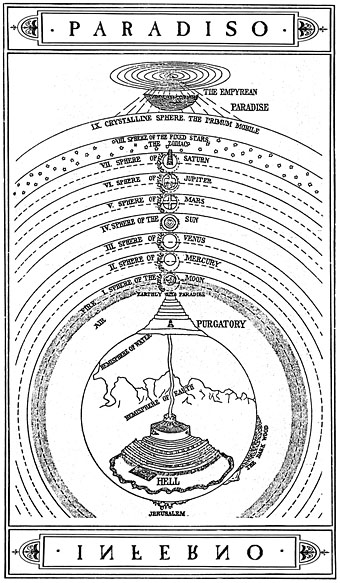by Alyssa Granacki
In Paradise 4 (22-24), Beatrice addresses Dante’s doubts, one of which concerns Plato’s doctrine and the relationship of the souls to the stars:
And you are also led to doubt because
the doctrine Plato taught would find support
by souls’ appearing to return to the stars
Ancor di dubitar ti dà cagione
parer tornarsi l’anime a le stelle
secondo la sentenza di Platone

Map of the Divine Comedy. Michelangelo Caetani (1804-1882).
Dante believes that souls must return to the star that ruled their earthly passions (i.e. the lustful would return to Venus). Beatrice responds that Dante cannot take Plato’s doctrine literally, which would lead him to the heretical belief that the stars rule our choices (such an idea would also contradict the explanation of free will given by Marco Lombardo in Purgatory 16). Beatrice further disproves Plato by explaining that the souls are not actually in the different stars physically, but rather are represented that way so that Dante might understand the organization of Paradise. Dante thus brings to light the importance of Plato’s thought, while simultaneously challenging the human ability to understand divine justice.

MS. Digby 23. © Bodleian Libraries, University of Oxford.
Dante and his medieval contemporaries did not read Greek, so they accessed Plato in fragments, spread across other texts. Of Plato’s works, only the Timaeus circulated with any cohesiveness in medieval Italy. Although Cicero translated the text into Latin, Calcidius’ 4th century translation would have been the version which Dante knew. Calcidius’ translation was not complete, but did contain sections on the organization of the universe as well as the nature of living things. Calcidius also included extensive commentary on the text, incorporating Judeo-Christian ideas about cosmology into his comments; an example of his commentary is visible in the manuscript Digby 23, located at the Bodleian Library in Oxford and pictured here.
In fact, several manuscripts of Calcidius’ translation, copied in the 12th century, still survive today. Both Conv. Soppr. J (S Marco) II.50, housed at the Biblioteca Nazionale Centrale in Florence, and MS Digby 23, include detailed drawings outlining the order of the stars and the universe. A map of the planets is visible in the drawing pictured here. The detail, color, and intricate sketches speak to the importance of the text for medieval scribes and scholars, who would have painstakingly completed the diagrams by hand. Dante may have consulted such images of the heavens as he imagined his own universal order; even maps of the afterworld dating from centuries later, like the 19th century one featured above, bring to mind the diagrams that accompanied Calcidius’ Timaeus.

MS Digby 23. © Bodleian Libraries, University of Oxford.
Selected Bibliography
Barolini, Teodolinda. “Paradiso 4 : Violence Versus Platonic Venom.” Commento Baroliniano, Digital Dante. Center for Digital Research and Scholarship. New York, NY: Columbia University Libraries, 2015. http://digitaldante.columbia.edu/dante/divine-comedy/paradiso/paradiso-4/
Calcidius. On Plato’s Timaeus, edited and translated by John Magee. Dumbarton Oaks Medieval Library, 2016. Encyclopædia Britannica Online, s. v. “Plato”, accessed May 18, 2016, http://www.britannica.com/biography/Plato.